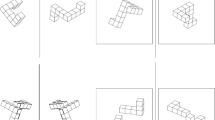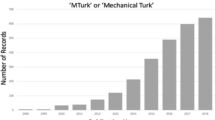Abstract
Many studies have evaluated the interplay of gravicentric, egocentric, and visual cues for our perception of the vertical, but little is known about their interplay for motor control. Thirty-five participants flipped a switch “down” in experimental conditions which systematically varied body posture (upright; tilted 45° left-ear-down), visually indicated vertical (absent; aligned with the long body axis; rotated 45° counterclockwise with respect to the long body axis), and egocentric tactile information provided by a handhold (absent; present). Since we were interested in the participants’ habitual rather than an instructed motor vertical, we did not specify which cues they should rely on. Our data revealed two response categories. Type-1 responses depended moderately on switch position; they relied mainly on gravicentric and egocentric cues, but only marginally on visual cues. Type-2 responses depended strongly on switch position; they relied on egocentric, but not on gravicentric or visual cues. We interpret the dependence on switch position as evidence that egocentric cues for type-2 responses may be anchored in the participants’ arm rather than in their long body axis. In conclusion, the habitual motor vertical can vary when available cues are not aligned, and this variability can compromise manual performance of human operators.





Similar content being viewed by others
References
Barra J, Benaim C, Chauvineau V, Ohlmann T, Gresty M, Pérennou D (2008) Are rotations in perceived visual vertical and body axis after stroke caused by the same mechanism? Stroke J Cereb Circ 39(11):3099–3101. https://doi.org/10.1161/STROKEAHA.108.515247
Betts GA, Curthoys IS (1998) Visually perceived vertical and visually perceived horizontal are not orthogonal. Vis Res 38(13):1989–1999. https://doi.org/10.1016/S0042-6989(97)00401-X
Bock O, Bury N (2016) Flipping a switch “down” when not aligned with the gravitational vertical. Aerosp Med Hum Perform 87(10):838–843. https://doi.org/10.3357/AMHP.4559.2016
Bock O, Bury N (2018) Interplay of gravicentric, egocentric and visual cues about the vertical in the control of arm movement direction. Perception 47(3):296–305. https://doi.org/10.1177/0301006617746842
Bury N, Bock O (2016) Role of gravitational versus egocentric cues for human spatial orientation. Exp Brain Res 234:1013–1018. https://doi.org/10.1007/s00221-015-4526-z
Ceyte H, Cian C, Nougier V, Olivier I, Trousselard M (2007) Role of gravity-based information on the orientation and localization of the perceived body midline. Exp Brain Res 176(3):504–509. https://doi.org/10.1007/s00221-006-0764-4
Dyde RT, Jenkin MR, Harris LR (2006) The subjective visual vertical and the perceptual upright. Exp Brain Res 173(4):612–622. https://doi.org/10.1007/s00221-006-0405-y
Ebenholtz SM (1970) Perception of the vertical with body tilt in the median plane. J Exp Psychol 83(1):1–6. https://doi.org/10.1037/h0028518
Ebenholtz SM (1977) Determinants of the rod and frame effect: the role of retinal size. Percept Psychophys 22(6):531–538. https://doi.org/10.3758/BF03198759
Ernst MO, Banks MS (2002) Humans integrate visual and haptic information in a statistically optimal fashion. Nature 415:429–433. https://doi.org/10.1038/415429a
Hay JC, Pick HL Jr, Ikeda K (1965) Visual capture produced by prism spectacles. Psychon Sci 2(1–12):215–216. https://doi.org/10.3758/BF03343413
Howard IP, Childerson L (1994) The contribution of motion, the visual frame, and visual polarity to sensations of body tilt. Perception 23(7):753. https://doi.org/10.1068/p230753
Jenkin HL, Jenkin MR, Dyde RT, Harris LR (2004) Shape-from-shading depends on visual, gravitational, and body-orientation cues. Perception 33(12):1453–1461. https://doi.org/10.1068/p5285
Lackner JR, DiZio P (2000) Human orientation and movement control in weightless and artificial gravity environments. Exp Brain Res 130:2–26. https://doi.org/10.1007/s002210050002
Le Séac’h AB, McIntyre J (2007) Multimodal reference frame for the planning of vertical arms movements. Neurosci Lett 423(3):211–215. https://doi.org/10.1016/j.neulet.2007.07.034
Mittelstaedt H (1983) A new solution to the problem of the subjective vertical. Naturwissenschaften 70:272–281. https://doi.org/10.1007/BF00404833
Oruc I, Sinnett S, Bischof WF, Soto-Faraco S, Lock K, Kingstone A (2008) The effect of attention on the illusory capture of motion in bimodal stimuli. Brain Res 1242:200–208. https://doi.org/10.1016/j.brainres.2008.04.014
Paillard J (1991) Motor and representational framing of space. In: Paillard J (ed) Brain space, Oxford University Press, Oxford, pp 163–182
Rock I (1954) The perception of the egocentric orientation of a line. J Exp Psychol 48(5):367–374. https://doi.org/10.1037/h0057319
Spinelli D, Antonucci G, Daini R, Zoccolotti P (1995) Local and global visual mechanisms underlying individual differences in the rod-and-frame illusion. Atten Percept Psychophys 57(6):915–920. https://doi.org/10.3758/BF03206806
Toma S, Sciutti A, Papaxanthis C, Pozzo T (2015) Visuomotor adaptation to a visual rotation is gravity dependent. J Neurophysiol 113(6):1885–1895. https://doi.org/10.1152/jn.00369.2014
Witkin HA, Lewis HB, Hertzman M, Machover K, Meissner PB, Wapner S (1954) Personality through perception: an experimental and clinical study. Harper, Oxford
Acknowledgements
This work was supported by the Space Administration Department of the German Aerospace Center of the Federal Republic of Germany (DLR), with funds made available by the German Federal Ministry for Economic Affairs and Energy, based on a resolution of the German Federal Parliament; award code 50WB0726. We thank (in alphabetical order) Pia Dreiner, Jürgen Geiermann, Verena Hammes, Niklas Joisten, Michael Kalicinski, Thomas Kesnerus, Malte Kraul, and Hartmut Schink, for support in technical work, data collection, and analysis.
Author information
Authors and Affiliations
Corresponding author
Rights and permissions
About this article
Cite this article
Bury, N., Bock, O. The habitual motor vertical of humans depends on gravicentric and egocentric cues, but only little on visual cues. Exp Brain Res 236, 2545–2552 (2018). https://doi.org/10.1007/s00221-018-5316-1
Received:
Accepted:
Published:
Issue Date:
DOI: https://doi.org/10.1007/s00221-018-5316-1




